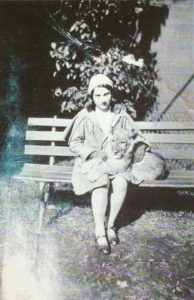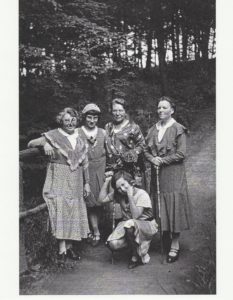We are pleased to feature a series of blog posts in honor of Yom Hashoah, Holocaust Remembrance Day, which falls on Tuesday, April 21 this year. The posts were written and researched by Kristen Byrnes, an alum of the UNC Asheville History Department who is currently enrolled in UNC Greensboro’s Master of Library and Information Studies program. Kristen did this work as part of her practicum through UNCG’s MLIS program, working with several collections from UNCA’s Jewish Life in Western North Carolina Collections to illustrate the impact of the Holocaust on individuals. This first of four posts tells the story of Hilde Hoffman. Kristen’s posts will come out each week during April.
– Gene Hyde, Head of Special Collections.
This year’s Yom Hashoah, or Holocaust Remembrance Day, is particularly special as this year marks the 75th anniversary of the end of World War II. In honor of this event, we will be celebrating our local Jewish community with a series of posts that highlight Holocaust survivors in Western North Carolina. These posts will pull from two incredible collections at are housed at Special Collections: Choosing to Remember: From the Shoah to the Mountains and the Sharon Fahrer Holocaust Collection, a new addition to our repository. Please enjoy the first installment of our Remembering the Holocaust series as we learn about Hilde Hoffman’s story.
Prejudice: A Learned Behavior:
Hilde Hoffman’s Story

At first, the rise of the Nazis wasn’t particularly alarming, Hilde remembers. “I just heard the marching of big armies of people, marching and demonstrating and singing and the running around with flags and in the beginning, it seemed like just a very patriotic behavior after the war and no personal fear was felt. It wasn’t until… the end of 1934 when new rules were made.” These rules—which would change how Jews related and interacted with the rest of society—were even felt, though not always understood, by children.
From a young age Hilde knew she was Jewish, but that was the only difference she could see between herself and Lottie, her best friend who was not Jewish. Hilde and Lottie’s friendship continued during the rise of the Nazi party. The Nazis began to inject segregation into Germany’s school systems, prohibiting Jewish children from playing with their classmates at recess. They were made to eat lunch separately as well. Hilde remembers this isolation as absolutely devastating. Eventually, non-Jewish people were no longer allowed to interact with Jews. Despite this rule, Lottie’s aunts—at great risk to themselves—insisted Hilde accompany the aunts and Lottie on a vacation under the guise that Hilde was just another one of their nieces. This was the summer of 1934. This, Hilde says, show that “sincere friends are willing to take tremendous chances.” Hilde took a chance herself when she snuck into the church to see Lottie’s confirmation, an act that was absolutely forbidden. Hilde later received a photograph in the mail of Lottie in her white confirmation dress. Lottie’s confirmation in the Spring of 1935 would be the last time Hilde ever saw her.
“Prejudice is something we learn. We either learn it by seeing it from our elders, or it is taught in some schools, maybe, and we have to be careful that we don’t indulge in that because it’s going to poison our outlook in life and it limits our abilities…”
She also remembers witnessing segregation in larger society as Jews were prohibited visiting public places such as the theater, concerts, even the zoo. This was another shattering blow to Hilde, who had long loved the zoo. Since Hilde visited the zoo multiple times a week, she was familiar with all the zookeepers. She recalls the birth of a lion cub who was rejected by its mother. The zookeeper took this cub and placed it with his dachshund who had just given birth to puppies. The dachshund nursed the lion cub for a few weeks until the cub grew too large and the keepers began to bottle feed it. Throughout this time, Hilde visited the zoo often and knew of the lion cub’s progression. On the last day Jews were allowed to visit the zoo, Hilde’s father took her one last time. The zookeeper, seeing Hilde crying said, “if you father has a camera with him, why don’t you have your picture taken with your lion cub because then you’ll always remember.” Hilde sat on a bench with the cub, talked to him, and had her photo take with him.

Hilde’s message for us is a call to educate ourselves. “You live in a free country, this is probably the best country in the whole world […] At one time Germany was a beautiful country, Russia was a more or less beautiful country, look what happened to all these countries because people didn’t care enough to maintain their society at a certain level of broadmindedness […] Try to get to know as many people as you can of as many different religions, of as many different nationalities or if you can travel you see them in their own country, which is even more educational. And after a while you will understand that doing this, you’re not losing a thing of your own identity, but you’re enriched by the things that you can learn from other people and that they can learn from you. And most of all, prejudice isn’t born in nobody. No baby ever that I’ve met and I’ve met a lot of babies, has shown any kind of prejudice. So prejudice is something we learn. We either learn it by seeing it from our elders, or it is taught in some schools, maybe, and we have to be careful that we don’t indulge in that because it’s going to poison our outlook in life and it limits our abilities and I think it takes away some of our happiness.”
Hilde’s story is part of the Choosing to Remember: From the Shoah to the Mountains collection at D.H. Ramsey Library Special Collections, located at the University of North Carolina Asheville. This collection is a compilation of oral histories of Holocausts survivors. For more information on Hilde and other survivors’ stories, visit Ramsey Library Special Collection’s online finding aid.
For Hilde’s full interview, please see the video below.
– Kristen Byrnes
